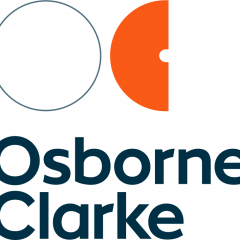Who: Enterprise Holdings, Inc. (“Enterprise”), Europcar Group UK Limited and Europcar International SASU (together, “Europcar”)
Where: UK
When: 13 January 2015
Law stated as at: 3 February 2015
What happened:
Enterprise and Europcar are competing providers of vehicle rental services. In 2012 Enterprise commanded a 30.1% share of the UK market in vehicle leasing, while Europcar had 26%.
For many years Enterprise’s flagship brand, Enterprise Rent-A-Car, has used a stylised lower case ‘e’ logo on a green background as a prominent part of its branding. Since December 2012, Europcar has made increasing use of a stylised lower case ‘e’ logo on a green background (see below, right). As a result of this use, Enterprise issued proceedings against Europcar for trade mark infringement and passing off.
Enterprise’s claim identified a total of three UK trade marks and seven Community Trade Marks (“CTM”). At the time of trial, however, three of the CTMs were the subject of cancellation proceedings and Enterprise’s claim in relation to those marks was therefore stayed. The case focussed on CTM No. 9374497, which is registered in black and white in relation to “vehicle rental and leasing services” (see below).
Trade mark owners generally have the right to restrict the use of identical or similar marks when used in connection with identical or similar goods or services, if such use is likely to confuse the public as to the trade origin of the goods or services.
Enterprise alleged that: (1) a likelihood of confusion had arisen from Europcar’s use of the ‘e’ logo; (2) such use took advantage of the repute in Enterprise’s trade mark; and (3) Europcar’s logo was detrimental to the distinctive character of Enterprise’s trade marks.
Likelihood of confusion
During the case, Europcar argued that the context in which it used the ‘e’ logo – in combination with the main Europcar logo or with other secondary brands – negated any likelihood of confusion. In his judgment, Arnold J agreed that the context of use could reduce the likelihood of confusion, but that it had not done so in this instance. The use of other Europcar branding devices in conjunction with the ‘e’ logo did not change the fact that the logo played its own independent role in the company’s branding. In any event, Europcar’s defence was not helped by the fact that Enterprise identified several examples where Europcar had used the logo on its own – such as the icon for its mobile app.
It is interesting to note that in his judgment, Arnold J accepted that there was “not a great deal” of similarity between the logos used by the rival companies. He suggested that “anyone who was able to compare the two logos would not mistake them”.
The lack of objective similarity notwithstanding, Arnold J held that it would be feasible for someone with only “an imperfect recollection of the Enterprise logo” to see the Europcar logo and “mistake the latter for the former, at least in the absence of any differentiating context”.
Arnold J also agreed with Enterprise’s assertion that there had been an “undercurrent of confusion” between the competitors, even before Europcar began using its own ‘e’ logo and that this was a factor he had to consider when assessing whether there was a likelihood of confusion. However the judge did not accept the position that any pre-existing undercurrent of confusion meant that Europcar was under a special duty not to take any steps which might exacerbate the risk of confusion.
Distinctive character and the use of surveys
In assessing whether or not the Enterprise mark had distinctive character, the judgment gave weight to witness evidence that “the green ‘e’ has a life of its own and… within the industry it is synonymous with Enterprise. In the field of car rental it is ‘short hand’ for Enterprise – a brand in its own right, much in the same way that McDonald’s ‘M’ is a short hand for them in the fast food industry”. These statements were affirmed by consumer surveys commissioned by Enterprise in an attempt to show that a significant portion of the public recognised the ‘e’ logo as being associated with Enterprise.
The use of survey evidence in this case is interesting. In the wake of the Court of Appeal decisions in Interflora v Marks & Spencer, many predicted that the use of survey evidence in trade mark proceedings become a thing of the past.
Interflora drastically raised the threshold for admissibility, such that survey evidence should not be admitted unless it is likely to be of real value to the court. The likely value of the evidence must also justify the cost of conducting the survey.
Arnold J considered the consumer survey evidence and found that it was indicative of the fact that the Enterprise mark “has an enhanced distinctive character as a result of the use which has been made of it in relation to vehicle rental services”. But the judge was clearly unconvinced of the real value of the surveys, commenting that they were “confirmatory of the conclusion which I would in any event be minded to reach in light of all of the other evidence in the case”.
Actual confusion
Arnold J held that Europcar had infringed Enterprise’s CTM under Article 9(1)(b) of the Community Trade Mark Regulations. Despite the lack of objective similarity between the two logos, the inherent and enhanced distinctive character of the Enterprise mark and the average consumer’s varying or neutral level of attention meant that there was a likelihood of confusion. But it was evidence of actual confusion that was the final nail in the coffin for Europcar.
In a somewhat comical twist, Europcar’s own evidence showed that between January 2013 and October 2014, Europcar customers had mistakenly boarded the Enterprise shuttle bus at Heathrow Airport on at least 529 occasions – the judge considered that the only viable explanation for such confusion was Europcar’s use of the ‘e’ logo from late 2012 onwards. This convinced Arnold J that Europcar’s use of the ‘e’ logo infringed the Enterprise CTM, even when it was used in combination with other Europcar branding. Without evidence of actual confusion, the judge “would have hesitated as to whether to reach the same conclusion”.
In addition to trade mark infringement, Arnold J also concluded that Europcar’s actions constituted passing off. He was not persuaded, however, that Europcar’s use of the ‘e’ logo had caused detriment to the distinctive character or repute of the Enterprise trade mark – there was no evidence of any change in the economic behaviour of the average consumer to support such a claim.
Why this matters:
The decision may set some alarm bells ringing, given the lack of objective similarity between the Enterprise mark and Europcar’s infringing logo.
Nonetheless, the case reinforces the commercial importance of having a distinct and identifiable brand, particularly for providers of goods or services that compete directly with others in the same market. A logo or other branding device that is sufficiently distinct to enable consumers to identify trade origin will avoid allegations of infringement and will usually be enforceable against third parties.
The outcome is also reassuring for businesses that have invested in brand development. As the use of short-hand logos becomes increasingly common – especially in the context of digital services or mobile apps – the commercial value of a recognisable brand should not be underestimated.








